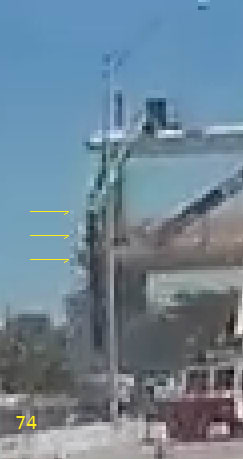RAB678 (Mechanical) 13 Jul 19 19:20 said:
...Bridge photogrammetry 17 by Zac Doyle also on youtube. On my monitor, I can see the end of the crane, vibrate what looks like twice.
:
Also notice a black lifting strap? suddenly shoot upwards out of the picture.
[ol 1]
[li]When you talk about a URL or video, attach a link so we can read/see exactly what you are talking about.[/li]
[li]If you look at the
Collapse - N View video you will see that the crane cables are slack and not carrying any weight, right up to the collapse at the end of the video.[/li]
[li]The Zac Doyle video is a heavily processed and interpolated version of the original 1280x720
dash cam video. Whenever there is motion, such as approaching the bridge as shown in the dash cam video, a thin object such as the crane mast will seem to shimmer, shake, etc. because the interpolation area of interest (a small group of pixels) is shifting one row/column of pixels in the direction of motion. As an example of what you were actually looking at, here is a cropped area of the crane mast from dash-cam video Frame 75:
[/li]
[li]Also note that the tip of the crane mast has a small eastward extension (see the
N- view video) and the dash-cam truck is approaching from a direction where this extension is just coming into view from behind the mast, so there are only a few pixels visible to begin with, and one or two more pixels become visible in each new frame.[/li]
[li]The lifting strap, as you call it, is visible in all frames (see the
N-view video), but since it is so thin (only one pixel wide) it may seem to lighten in color (disappear) as it moves from one column of pixels to the next as the dash-cam truck moves closer. See Frame 75 (above) as an example - in some places there doesn't appear to be any cable at all, but if you look closer some pixels in the column containing the cable are a slightly different color than the background.[/li]
[li]For these and other reasons, the way we usually examine videos here is frame-by-frame using the original source. I "enlarge" the frames using an algorithm that replaces each original pixel with a 4x4 block of identical pixels, because just about any other enlargement method will introduce significant interpolation artifacts (stuff that really isn't there). We may have disagreements over what a group of pixels actually represent, but at least we are confident we are all look at exactly the same thing, but just have different interpretations.[/li]
[li]The Doyle video and others are heavily processed, usually with an intent to "enhance" something the author imagines is there. Something similar is done here, on occasion, but the author can explain exactly what was done and why, so everyone else understands the motive and the result, and so they can ask informed questions.[/li]
[li]Don't rely solely on one video when there are more available. Most of your questions are answered (and claims dismissed) by simply looking at the
N-View video, for example. The bridge installation and collapse was monitored continuously by at least 3 time-lapse cameras. These are labeled N-view, SW-view and SE-view in my PlayList of
Bridge Timelapses videos. Other viewpoints also exist for parts of the move - see my
Dropbox Playlist. [/li]
[/ol]


